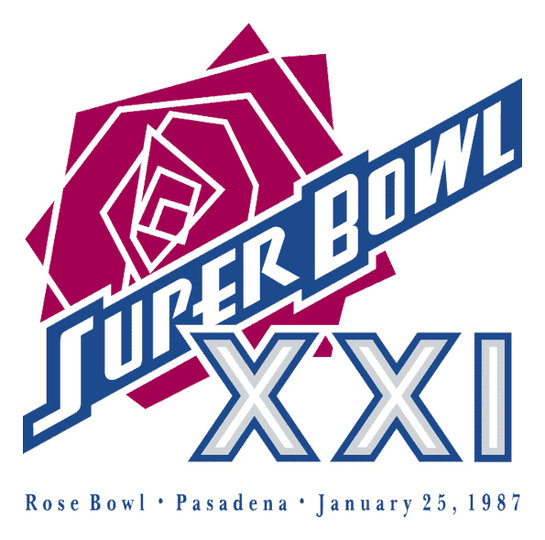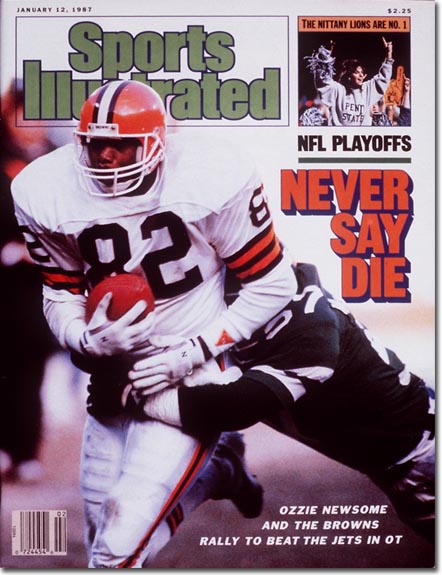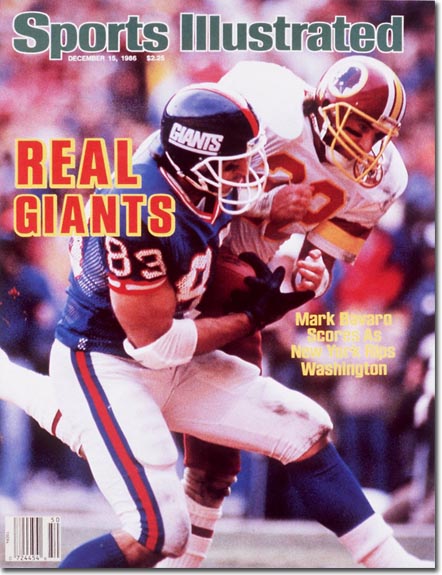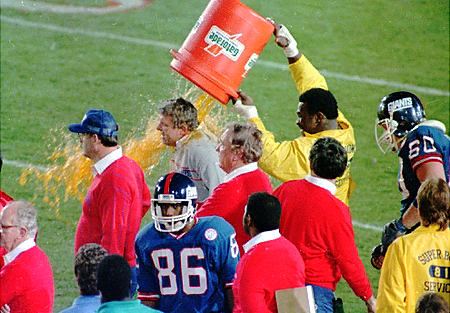 Browns Archive
Browns Archive  Alternate History: Super Bowl XXI
Alternate History: Super Bowl XXI

With Super Bowl XLVI fast approaching, it’s time to take a trip into the only land that houses a Cleveland Browns Super Bowl- the land of make-believe. In Turtledove-esque fashion, let’s go back a quarter of a century and make some alternative history. In this history, the Browns bedevil the Broncos in both the 1986 and ’87 AFC Championship Games to reach consecutive Super Bowls against the New York Giants and Washington Redskins. Here is the story of those Super Bowls.
Super Bowl XXI
January 25, 1987: the Rose Bowl, Pasadena, CA
New York Giants (14-2) vs. Cleveland Browns (12-4)
For old-time NFL fans, the Super Bowl XXI matchup between the Giants and Browns brought pangs of nostalgia. During the 1950’s and ‘60s the teams forged one of the league’s great rivalries, twice meeting in conference playoff games and dominating the Eastern Conference between them. Both teams had fallen on hard times in the 1970’s but had experienced a rebirth in the ‘80s. Now they would meet in the Super Bowl, the first time in the big game for both franchises.
The rise of the Giants began in 1981 with the selection of Lawrence Taylor on the first round of the Draft. It took shape in 1982 with the ascension of assistant Bill Parcells to the head-coaching spot. Playoff wins came in ’81, ’84 and ’85. In 1986, New York made its breakthrough, compiling the league’s best record and crushing talented 49er and Redskin teams in the Playoffs by a combined score of 66-3. The Giants came into Pasadena on an eleven-game winning streak. They hadn’t lost in more than three months.
They did it with a formula very familiar to longtime fans of the Big Blue: physical, low-risk offense and dynamic defense. Veteran quarterback Phil Simms guided the attack, a solid starter after being alternately booed, banged-up and bench early in his career. Little Joe Morris finished second in the NFL with 1,516 rushing yards while young tight end Mark Bavaro, a hero in the Big Apple with his Stallone-esque essence and almost supernatural toughness, made 66 catches for 1,001 yards.
Defensively is where the Giants excelled, however. Led by Taylor, only the second defender to win MVP honors, New York finished second in scoring and total defense, racked up 59 sacks and yielded a league-low in rushing yards. The defense raised its game to a new level in the postseason, not allowing a touchdown in eight quarters, with Jim Burt’s devastating shot on Joe Montana the symbol of its dominance. Overall the Giants looked every bit as powerful as the Bears and 49ers teams that had pulled off Super Bowl routs the previous two seasons.
Cleveland’s rise was more sudden and unexpected. Two years earlier the Browns went 5-11 and fired head coach Sam Rutigliano. Phlegmatic Marty Schottenheimer took over and gradually shaped a team of low-round picks and USFL refugees into a respectable outfit. He got a big help along the way from the most celebrated young player the town had seen since the days of Jim Brown.
Boardman native Bernie Kosar had always dreamed of playing for the Browns, and he manipulated the Supplemental Draft rules to make it happen. In 1986 the gangly Kosar became the NFL’s next great quarterback, throwing for 3,854 yards and injecting new explosiveness into what had been a staid Cleveland offense. Led by the hometown boy, the Browns won eight of nine after a 4-3 start and surprised the experts by grabbing the top seed in the AFC.
 They then punched their Super Bowl ticket with a pair of thrilling victories. First, Kosar threw for a postseason-record 489 yards as Cleveland overcame a ten-point deficit in the last four minutes and topped the Jets in double-overtime. In the AFC title game Brian Brennan’s sensational 48-yard touchdown reception broke a 13-13 tie late in the fourth quarter and vaulted the Browns past the Broncos and into their first Super Bowl, where they would meet their ancient rivals from the big city.
They then punched their Super Bowl ticket with a pair of thrilling victories. First, Kosar threw for a postseason-record 489 yards as Cleveland overcame a ten-point deficit in the last four minutes and topped the Jets in double-overtime. In the AFC title game Brian Brennan’s sensational 48-yard touchdown reception broke a 13-13 tie late in the fourth quarter and vaulted the Browns past the Broncos and into their first Super Bowl, where they would meet their ancient rivals from the big city.
New York came in a solid touchdown favorite, and rightfully so. The Giants had a better record, played in the superior conference and were far more imposing statistically. They also had more big-game experience; New York’s core of LT, Phil Simms and Harry Carson had won five playoff games since 1981, while Cleveland’s win over the Jets was its first postseason win since 1969. At 23 Bernie Kosar was the youngest starting quarterback in Super Bowl history, and he would have to navigate New York’s brilliant defense and its young mastermind, Bill Belichick. Plus, the NFC Champion had won the previous two Super Bowls by an average score of 42-13.
Cleveland had won the most recent installment, however, defeating the Giants at the Meadowlands in a wild, back-and-forth game the previous year. Nobody anticipated a similar shootout on this day, nor did anyone take that year-old result as a harbinger.
The old Browns-Giants wars had been waged in the ice and mud of New York’s Yankee Stadium and Cleveland’s Municipal Stadium. The latest installment, however, was played on a sun-splashed Southern California afternoon; field manicured perfectly, the end zones painted in bright red and resplendent orange. New York wore its home blue jerseys; Cleveland, the designated road team, wore its preferred all-whites. After Neil Diamond sang the National Anthem, former Packer great Willie Davis (a 1958 Browns draftee) tossed the coin; the Browns won and elected to receive.
Gerald McNeil ran the kickoff back to the 22 and from there Kosar went to work on New York’s one defensive weakness- its suspect secondary. Slicing and dicing the Giants on quick timing patterns to the outside, Bernie nickel-and-dimed his team to a third-and-two at the Cleveland 49. He then got the big play, finding Webster Slaughter deep behind Elvis Patterson for 37 yards to the New York 14-yard line. Bernie the Kid had been sensational in the AFC Playoffs; he picked up where he left off against the NFL’s best defense.
Deep in Giant territory now, the Browns turned to their run game- and the results were less successful. The Giants swarmed Kevin Mack on two straight plays and after Kosar’s third-down pass was nearly intercepted by Perry Williams, Cleveland was forced to try the field goal. Mark Moseley’s 29-yard kick was true and five minutes into Super Bowl XX the Browns owned a 3-0 lead. It marked the first time the Giants trailed in a game since the third period of Week 13- a span of 22 quarters.
They didn’t trail for long in this one. On third-and-nine from his own 23, Simms found Mark Bavaro between the hashmarks for a 21-yard gain. When Joe Morris scooted for 16 on the next play, New York was in business. Two more third-down conversions set up a first-and-goal from the Cleveland one. Anticipating a run, the Browns went for a play-fake and Simms found Zeke Mowatt wide-open for the go-ahead touchdown. Raul Allege’s extra point made it 7-3 with four-and-a-half minutes remaining in the first period.
Inspired by the touchdown, the Giants then put the clamps on Cleveland’s offense. Eschewing the blitz, Belichick dropped his defenders into zones, hoping to lure young Kosar into a trap. The move paid off early in the second period when Kosar underthrew Ozzie Newsome and was intercepted at midfield by roaming linebacker Gary Reasons, who returned the gift to the Cleveland 39.
With the momentum on their side, the Giants immediately went for the early knockout punch. On first down Joe Morris took a handoff and flipped the ball back to Simms, who went deep for a streaking Phil McConky. The little Naval Academy alumnus made an acrobatic catch of the flea-flicker at the three-yard line, hanging on despite being blasted by Chris Rockins. Joe Morris dove over on the next play and the New Yorkers led 14-3 with 11:58 to go before halftime.
Three plays later Kevin Mack had the ball ripped away and recovered by Jim Burt at the Cleveland 22. With the AFC’s third consecutive Super Bowl blowout staring them squarely in the face, the Browns defense responded. Frank Minnifield’s open-field tackle denied Joe Morris a big gain on first down, and on third-and-seven from the 19, Reggie Camp beat Pro Bowl tackle Brad Benson and dropped Simms for a nine-yard loss. Allegre then hooked a 45-yard field-goal attempt and the Browns were off the hook.
With 2:52 remaining in the half the Browns took over at their 34-yard line following a Sean Landeta punt. Down 14-3 and with New York getting the second-half kickoff, Cleveland needed to get something out of this possession.
Kosar had been 3-of-11 with an interception since the first drive, but he got hot now, finding Brian Brennan and Ozzie Newsome on consecutive aerials and moving the Browns to the New York 44. Earnest Byner, who had missed most of the season with an ankle injury, slashed for five yards on a draw play, caught a short pass and retired to the sidelines for the rest of the day after the limb stiffed up.
the Browns to the New York 44. Earnest Byner, who had missed most of the season with an ankle injury, slashed for five yards on a draw play, caught a short pass and retired to the sidelines for the rest of the day after the limb stiffed up.
Spreading the field, Kosar hooked then up with Clarence Weathers and the little-used speedster- who had scored in the win over the Giants the previous season- raced all the way to the New York 16 before being collared. Two plays later, with 34 seconds left in the half, Kosar hit a diving Herman Fontenot for the first Super Bowl touchdown in franchise history. Cleveland had weathered the storm and trailed by a manageable 14-10 at halftime.
The Browns had to feel fortunate they weren’t down by more. Outgained 194-131, Cleveland was also being outplayed. Kosar had 111 yards through the air but was just 8-of-19 with the interception. Other than Byner’s late burst, the Browns had been stymied on the ground, picking up just 23 yards against the number-one ranked Giants run defense.
New York was more balanced offensively, gaining 114 yards passing and 80 rushing. Joe Morris and Co. had run well in the first half and Phil Simms had been coolly efficient, completing 7-of-11, avoiding the turnover and making big throws on both touchdown drives. Were it not for some missed opportunities and the defensive lapse late in the half, the Giants may very well have put the game away already. Instead they settled for the first single-digit halftime lead in a Super Bowl in five years.
They came out in the second half determined to increase that lead immediately. Taking the opening kickoff, New York moved smartly, using Morris’s runs and a series of short passes to gain a first down at midfield. There the drive stalled, however, when on third down Minnifield brilliantly tipped away a pass intended for Lionel Manuel. Out came All-Pro punter Sean Landeta, who figured to pin the Browns deep and force them to drive the length of the field against the best defense in football.
Cleveland’s Bill Cowher-coached special-teams unit was also the best in football, however, and the blocked punt was one of its specialties. Nobody walled off Felix Wright as he raced in and stuffed Landeta’s punt, the ball spinning and rolling before being covered at the New York 31. Passes to Herman Fontenot and Ozzie Newsome set up a first-and-goal at the two. The Browns were six feet away from taking the lead in Super Bowl XXI.
They never got there. On first down Kevin Mack went right and was stood up by Harry Carson for no gain. On second down Mack tried the left side and was buried by Jim Burt and Leonard Marshall for no gain. On third down Kosar tried to fool the Giants with a play-action fake and a swing pass to Fontenot, but Carl Banks wasn’t having it. The third-year linebacker peeled off and ran down Fontenot for a four-yard loss, defusing the threat. Cleveland was forced to call on Mark Moseley, and the aging kicker cashed in the 23-yarder to make it 14-13 midway through the third quarter.
The failure to score the touchdown on the first-and-goal opportunity would haunt the Browns. For now they were within one and seemingly in control of the momentum. And when D.D. Hoggard stuck McConkey on the kickoff, New York was 88 yards from the end zone. What followed was one of the finest drives in Super Bowl history.
The key was Phil Simms, the much-maligned, much-doubted former first-round pick. The Giants faced four third downs on their drive, and four times Simms either passed or ran his way to the necessary yardage. On third-and-ten from his 29, Simms hit Bobby Johnson for twelve. On third-and-four from the 35, Simms found Lee Rouson out of the backfield for six. On third-and-eight from the Cleveland 47, Simms scrambled for the sticks and made it before being dragged down by Clay Matthews. Finally, on third-and-goal from the eight, Simms found Bavaro, who slammed into the end zone on the final play of the third period.
Raul Allegre caused hearts in Cleveland to jump when he lined the extra-point off the upright. But the ball glanced through and it was a two-score game at 21-13 as the fourth quarter began.
Pressing the issue, New York’s front seven now began to tee off on Bernie Kosar, who was throwing on almost every play. Sacks by George Martin and Lawrence Taylor, combined with a holding penalty, sent the Browns backward on their next possession. Jeff Gossett’s punt wobbled only 37 yards and the Giants took over in Cleveland territory. Now they turned to Joe Morris, and Little Joe responded with darting runs to move his team into field-goal range. Allegre was right there from 38 yards and New York’s advantage was now 24-13 with 10:09 to play.
Needing two touchdowns to win, Cleveland moved out to midfield on the strength of completions to Reggie Langhorne and Webster Slaughter. On second-and-eight from the New York 49, Kosar went to Brian Brennan in the left flat. But Leonard Marshall got a paw up and tipped the ball, and Pepper Johnson made the diving interception with 7:51 left.
Once again the Giants turned to Joe Morris to grind down the clock, and once again Little Joe came through, carrying the ball seven straight times. The seventh, a 21-yard burst off right tackle, made it first-and-goal at the three. With their backs to the wall, Cleveland’s defense rose up and stuffed New York on three plays, and Raul Allegre was again called on for the 21-yard field goal that made it 27-13 with 2:55 remaining.
 Facing a defense that willingly traded yards for time, the Browns gave their fans one last taste of success. Kosar led his team downfield against the clock, capping a 68-yard drive with a touchdown toss to Ozzie Newsome with 32 seconds to play. It was the 51st pass attempt of the game for Bernie, a Super Bowl record. It was also his last. New York recovered the onside kick and ran out the clock to preserve the 27-20 victory. At the end it was Parcells that got the Gatorade bath and it was Phil Simms, not Kosar that turned to the cameras and said that he was, “going to Disney World!”
Facing a defense that willingly traded yards for time, the Browns gave their fans one last taste of success. Kosar led his team downfield against the clock, capping a 68-yard drive with a touchdown toss to Ozzie Newsome with 32 seconds to play. It was the 51st pass attempt of the game for Bernie, a Super Bowl record. It was also his last. New York recovered the onside kick and ran out the clock to preserve the 27-20 victory. At the end it was Parcells that got the Gatorade bath and it was Phil Simms, not Kosar that turned to the cameras and said that he was, “going to Disney World!”
For of the two quarterbacks, it was Simms that gave the command performance. The blonde-haired veteran from Morehead State was all but perfect, completing 17-of-23 for 237 yards and two touchdowns with no interceptions. Joe Morris chipped in with 133 yards on 32 carries with a touchdown; the rugged Bavaro made seven catches for 83 yards and a score. New York piled up 403 total yards on the day and, other than the blocked punt, did not turn the ball over. Most importantly, the Giants went 11-of-18 on third downs.
Cleveland, meanwhile, finished with just 279 yards. 247 of those came off the arm of Bernie Kosar, who completed 22-of-45 with two touchdowns and two interceptions. The running game, all but abandoned in the second half, accounted for just 32 yards. For the Browns, their leading receiver was also a tight end. Ozzie Newsome made eight catches for 89 yards and a touchdown, leading a group of eight different Browns that caught at least one pass.
So the franchise’s first trip to the Super Bowl ended in disappointment, with the Giants celebrating their first World Championship since 1956 and the Browns still seeking their first since 1964. But there was plenty for Cleveland fans to take pride in. In one special season their team had gone from perennial also-ran status to the Super Bowl, where they performed admirably against a team that had been humiliating opponents right and left before this day. The thousands of Browns fans in the Rose Bowl expressed this pride in the roaring ovation they gave their team as the clock ran down to zero.
And this wasn’t the end of the road by any means. The Browns were still a young team, with Newsome, Clay Matthews and Carl “Big Daddy” Hairston the only starters over the age of thirty. With good health and fortune, this would not be the last Super Bowl. So as night descended on the Arroyo Seco, the mood of Cleveland fans was depression mixed with anticipation. 1986 had been one of the greatest seasons in franchise history- and 1987 had a chance to be even better.
- NBA Announces 2013-2014 Schedule
- Browns Ink Sharknado
- Sharknado A No-Show For Rookie Camp
- Trent Richardson Out Until Training Camp
- Browns Sign Brandon Jackson
- Carrasco Suspended Eight Games
- Browns Add to Wide Receiver Depth with David Nelson
- Browns Need to Learn from Past Draft Mistakes
- Browns Release Chris Gocong and Usama Young
- Browns Missing on Grimes Disappointing, But Not The End
The TCF Forums
- Official- Browns Coach Search/Rumors
Hikohadon (Tuesday, January 21 2014 1:24 PM) - Movies coming out
rebelwithoutaclue (Tuesday, January 21 2014 12:56 PM) - 2015 Recruiting
jclvd_23 (Tuesday, January 21 2014 12:38 PM) - The 2014 Offseason Thread
Larvell Blanks (Tuesday, January 21 2014 12:25 PM) - Chris Grant's first 3 drafts
Kingpin74 (Tuesday, January 21 2014 10:13 AM) - Mike Brown
YahooFanChicago (Monday, January 20 2014 11:15 PM) - 2014 Hoops Hockey Hijinx
jpd1224 (Monday, January 20 2014 4:44 PM) - 2014 Recruiting
jclvd_23 (Monday, January 20 2014 2:26 PM) - Wish List - #4 Pick
Hikohadon (Monday, January 20 2014 1:26 PM) - #1 overall pick Anthony Bennett
TouchEmAllTime (Sunday, January 19 2014 1:28 PM)



